Start at 2016-06-24 11:45:40
First, define topology of a map grid (2016-06-24 11:45:40)...
Second, initialise the codebook matrix (331 X 38) using 'linear' initialisation, given a topology and input data (2016-06-24 11:45:40)...
Third, get training at the rough stage (2016-06-24 11:45:40)...
1 out of 2 (2016-06-24 11:45:40)
updated (2016-06-24 11:45:40)
2 out of 2 (2016-06-24 11:45:40)
updated (2016-06-24 11:45:40)
Fourth, get training at the finetune stage (2016-06-24 11:45:40)...
1 out of 5 (2016-06-24 11:45:40)
updated (2016-06-24 11:45:40)
2 out of 5 (2016-06-24 11:45:40)
updated (2016-06-24 11:45:40)
3 out of 5 (2016-06-24 11:45:40)
updated (2016-06-24 11:45:41)
4 out of 5 (2016-06-24 11:45:41)
updated (2016-06-24 11:45:41)
5 out of 5 (2016-06-24 11:45:41)
updated (2016-06-24 11:45:41)
Next, identify the best-matching hexagon/rectangle for the input data (2016-06-24 11:45:41)...
Finally, append the response data (hits and mqe) into the sMap object (2016-06-24 11:45:41)...
Below are the summaries of the training results:
dimension of input data: 3051x38
xy-dimension of map grid: xdim=21, ydim=21
grid lattice: hexa
grid shape: suprahex
dimension of grid coord: 331x2
initialisation method: linear
dimension of codebook matrix: 331x38
mean quantization error: 23.6263000610265
Below are the details of trainology:
training algorithm: batch
alpha type: invert
training neighborhood kernel: gaussian
trainlength (x input data length): 2 at rough stage; 5 at finetune stage
radius (at rough stage): from 6 to 1.5
radius (at finetune stage): from 1.5 to 1
End at 2016-06-24 11:45:41
Runtime in total is: 1 secs
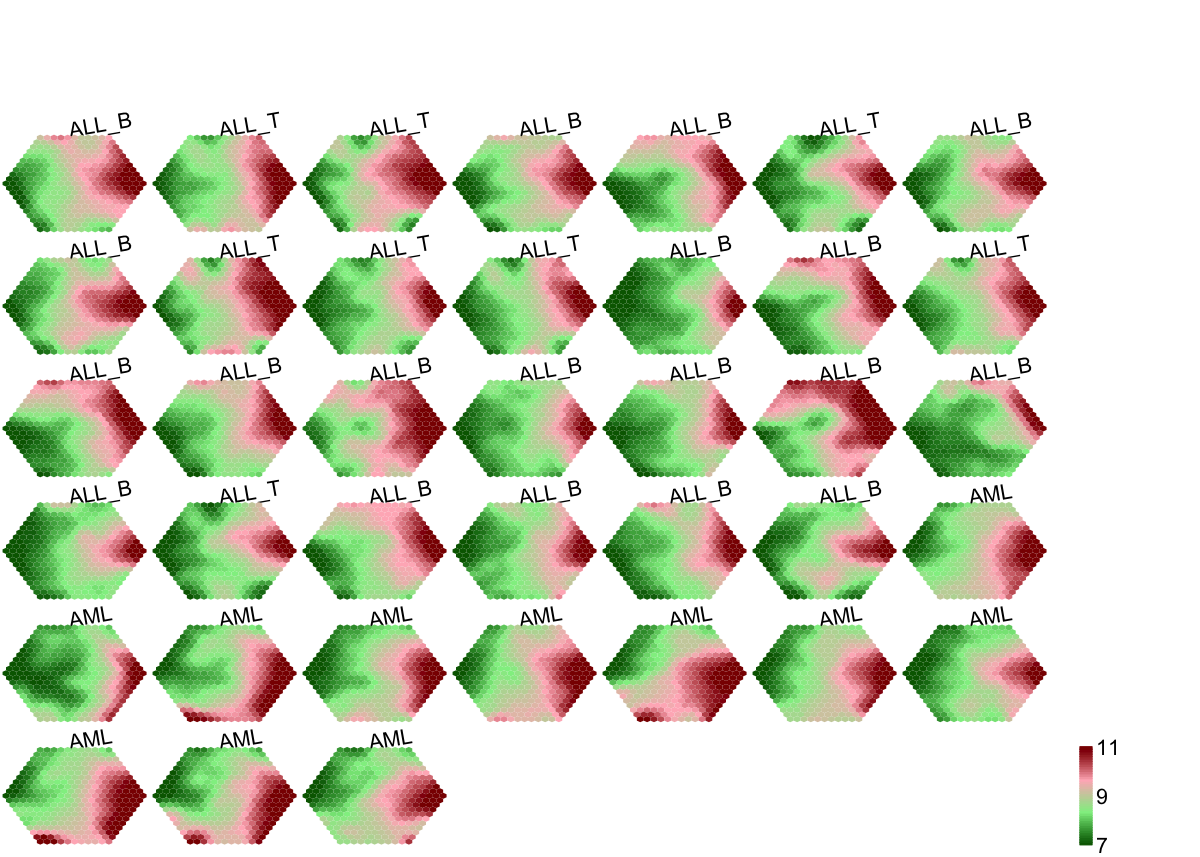
## As you have seen, a figure displays the multiple components of trained map in a sample-specific manner. You also see that a .txt file has been saved in your disk. The output file has 1st column for your input data ID (an integer; otherwise the row names of input data matrix), and 2nd column for the corresponding index of best-matching hexagons (i.e. gene clusters). You can also force the input data to be output; type ?
sWriteData for details.
# (III) Visualise the map, including built-in indexes, data hits/distributions, distance between map nodes, and codebook matrix
visHexMapping(sMap, mappingType="indexes")
## As you have seen, the smaller hexagons in the supra-hexagonal map are indexed as follows: start from the center, and then expand circularly outwards, and for each circle increase in an anti-clock order.
visHexMapping(sMap, mappingType="hits")
## As you have seen, the number represents how many input data vectors are hitting each hexagon, the size of which is proportional to the number of hits.
visHexMapping(sMap, mappingType="dist")
## As you have seen, map distance tells how far each hexagon is away from its neighbors, and the size of each hexagon is proportional to this distance.
visHexPattern(sMap, plotType="lines")
## As you have seen, line plot displays the patterns associated with the codebook matrix. If multple colors are given, the points are also plotted. When the pattern involves both positive and negative values, zero horizental line is also shown.
visHexPattern(sMap, plotType="bars")
## As you have seen, bar plot displays the patterns associated with the codebook matrix. When the pattern involves both positive and negative values, the zero horizental line is in the middle of the hexagon; otherwise at the top of the hexagon for all negative values, and at the bottom for all positive values.
# (IV) Perform partitioning operation on the map to obtain continuous clusters (i.e. gene meta-clusters) as they are different from gene clusters in an individual map node
sBase <-
sDmatCluster(sMap)
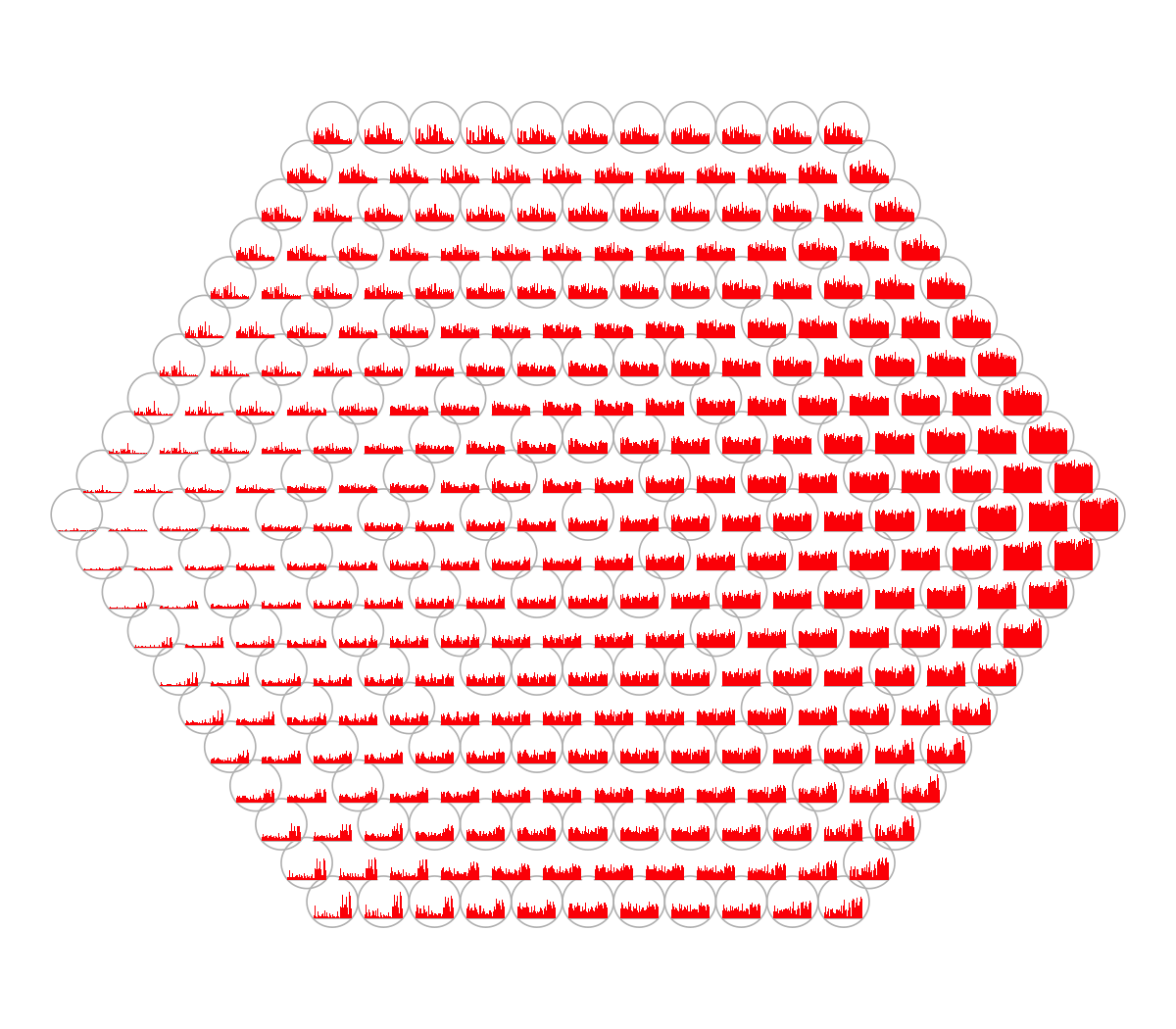
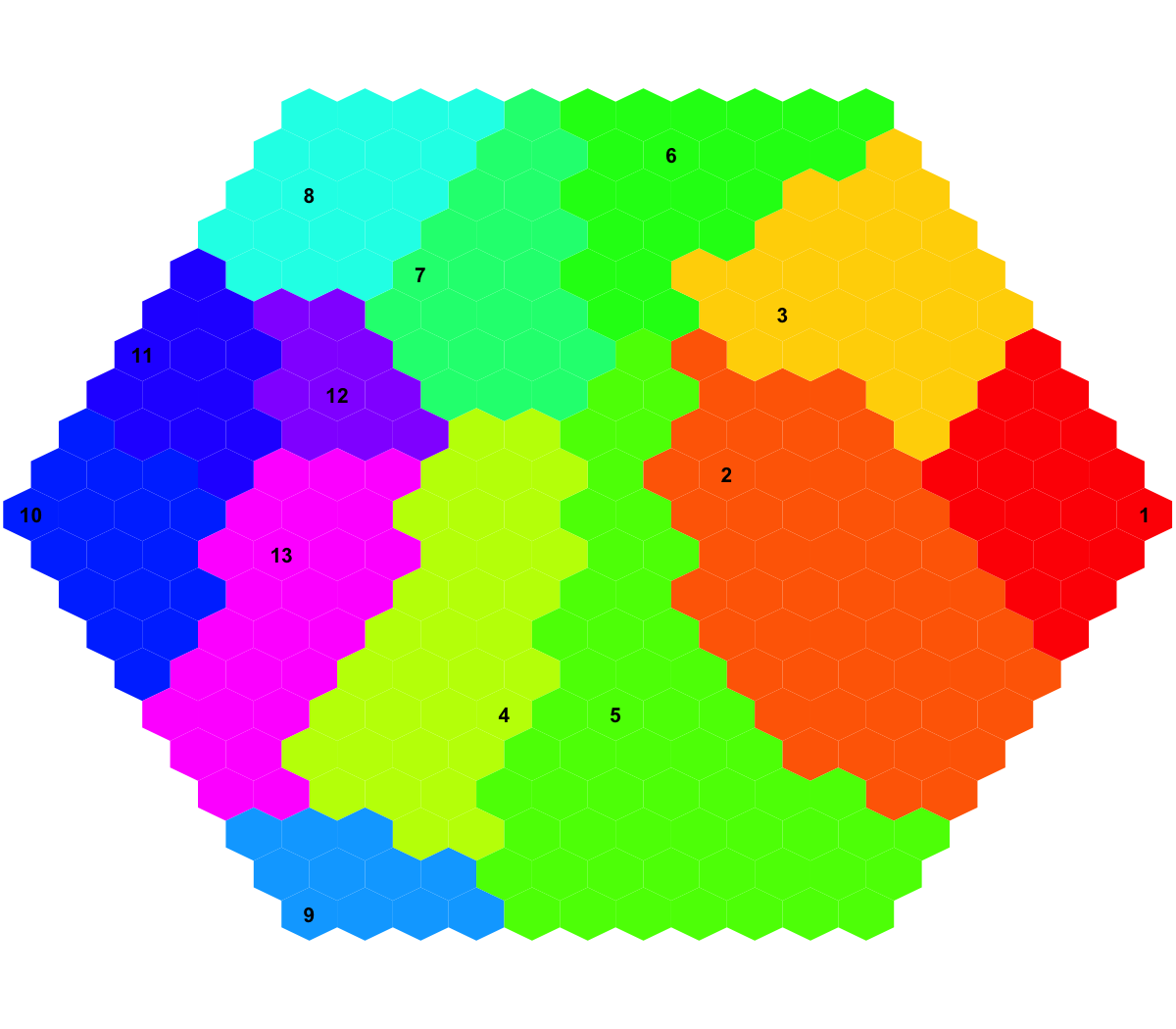 Start at 2016-06-24 11:45:47
First, define topology of a map grid (2016-06-24 11:45:47)...
Second, initialise the codebook matrix (117 X 38) using 'linear' initialisation, given a topology and input data (2016-06-24 11:45:47)...
Third, get training at the rough stage (2016-06-24 11:45:47)...
1 out of 1178 (2016-06-24 11:45:47)
118 out of 1178 (2016-06-24 11:45:47)
236 out of 1178 (2016-06-24 11:45:47)
354 out of 1178 (2016-06-24 11:45:47)
472 out of 1178 (2016-06-24 11:45:47)
590 out of 1178 (2016-06-24 11:45:47)
708 out of 1178 (2016-06-24 11:45:47)
826 out of 1178 (2016-06-24 11:45:47)
944 out of 1178 (2016-06-24 11:45:47)
1062 out of 1178 (2016-06-24 11:45:47)
1178 out of 1178 (2016-06-24 11:45:47)
Fourth, get training at the finetune stage (2016-06-24 11:45:47)...
1 out of 4712 (2016-06-24 11:45:47)
472 out of 4712 (2016-06-24 11:45:48)
944 out of 4712 (2016-06-24 11:45:48)
1416 out of 4712 (2016-06-24 11:45:48)
1888 out of 4712 (2016-06-24 11:45:49)
2360 out of 4712 (2016-06-24 11:45:49)
2832 out of 4712 (2016-06-24 11:45:49)
3304 out of 4712 (2016-06-24 11:45:50)
3776 out of 4712 (2016-06-24 11:45:50)
4248 out of 4712 (2016-06-24 11:45:50)
4712 out of 4712 (2016-06-24 11:45:51)
Next, identify the best-matching hexagon/rectangle for the input data (2016-06-24 11:45:51)...
Finally, append the response data (hits and mqe) into the sMap object (2016-06-24 11:45:51)...
Below are the summaries of the training results:
dimension of input data: 38x38
xy-dimension of map grid: xdim=13, ydim=9
grid lattice: rect
grid shape: sheet
dimension of grid coord: 117x2
initialisation method: linear
dimension of codebook matrix: 117x38
mean quantization error: 0.0621784272542971
Below are the details of trainology:
training algorithm: sequential
alpha type: invert
training neighborhood kernel: gaussian
trainlength (x input data length): 31 at rough stage; 124 at finetune stage
radius (at rough stage): from 2 to 1
radius (at finetune stage): from 1 to 1
End at 2016-06-24 11:45:51
Runtime in total is: 4 secs
Start at 2016-06-24 11:45:47
First, define topology of a map grid (2016-06-24 11:45:47)...
Second, initialise the codebook matrix (117 X 38) using 'linear' initialisation, given a topology and input data (2016-06-24 11:45:47)...
Third, get training at the rough stage (2016-06-24 11:45:47)...
1 out of 1178 (2016-06-24 11:45:47)
118 out of 1178 (2016-06-24 11:45:47)
236 out of 1178 (2016-06-24 11:45:47)
354 out of 1178 (2016-06-24 11:45:47)
472 out of 1178 (2016-06-24 11:45:47)
590 out of 1178 (2016-06-24 11:45:47)
708 out of 1178 (2016-06-24 11:45:47)
826 out of 1178 (2016-06-24 11:45:47)
944 out of 1178 (2016-06-24 11:45:47)
1062 out of 1178 (2016-06-24 11:45:47)
1178 out of 1178 (2016-06-24 11:45:47)
Fourth, get training at the finetune stage (2016-06-24 11:45:47)...
1 out of 4712 (2016-06-24 11:45:47)
472 out of 4712 (2016-06-24 11:45:48)
944 out of 4712 (2016-06-24 11:45:48)
1416 out of 4712 (2016-06-24 11:45:48)
1888 out of 4712 (2016-06-24 11:45:49)
2360 out of 4712 (2016-06-24 11:45:49)
2832 out of 4712 (2016-06-24 11:45:49)
3304 out of 4712 (2016-06-24 11:45:50)
3776 out of 4712 (2016-06-24 11:45:50)
4248 out of 4712 (2016-06-24 11:45:50)
4712 out of 4712 (2016-06-24 11:45:51)
Next, identify the best-matching hexagon/rectangle for the input data (2016-06-24 11:45:51)...
Finally, append the response data (hits and mqe) into the sMap object (2016-06-24 11:45:51)...
Below are the summaries of the training results:
dimension of input data: 38x38
xy-dimension of map grid: xdim=13, ydim=9
grid lattice: rect
grid shape: sheet
dimension of grid coord: 117x2
initialisation method: linear
dimension of codebook matrix: 117x38
mean quantization error: 0.0621784272542971
Below are the details of trainology:
training algorithm: sequential
alpha type: invert
training neighborhood kernel: gaussian
trainlength (x input data length): 31 at rough stage; 124 at finetune stage
radius (at rough stage): from 2 to 1
radius (at finetune stage): from 1 to 1
End at 2016-06-24 11:45:51
Runtime in total is: 4 secs
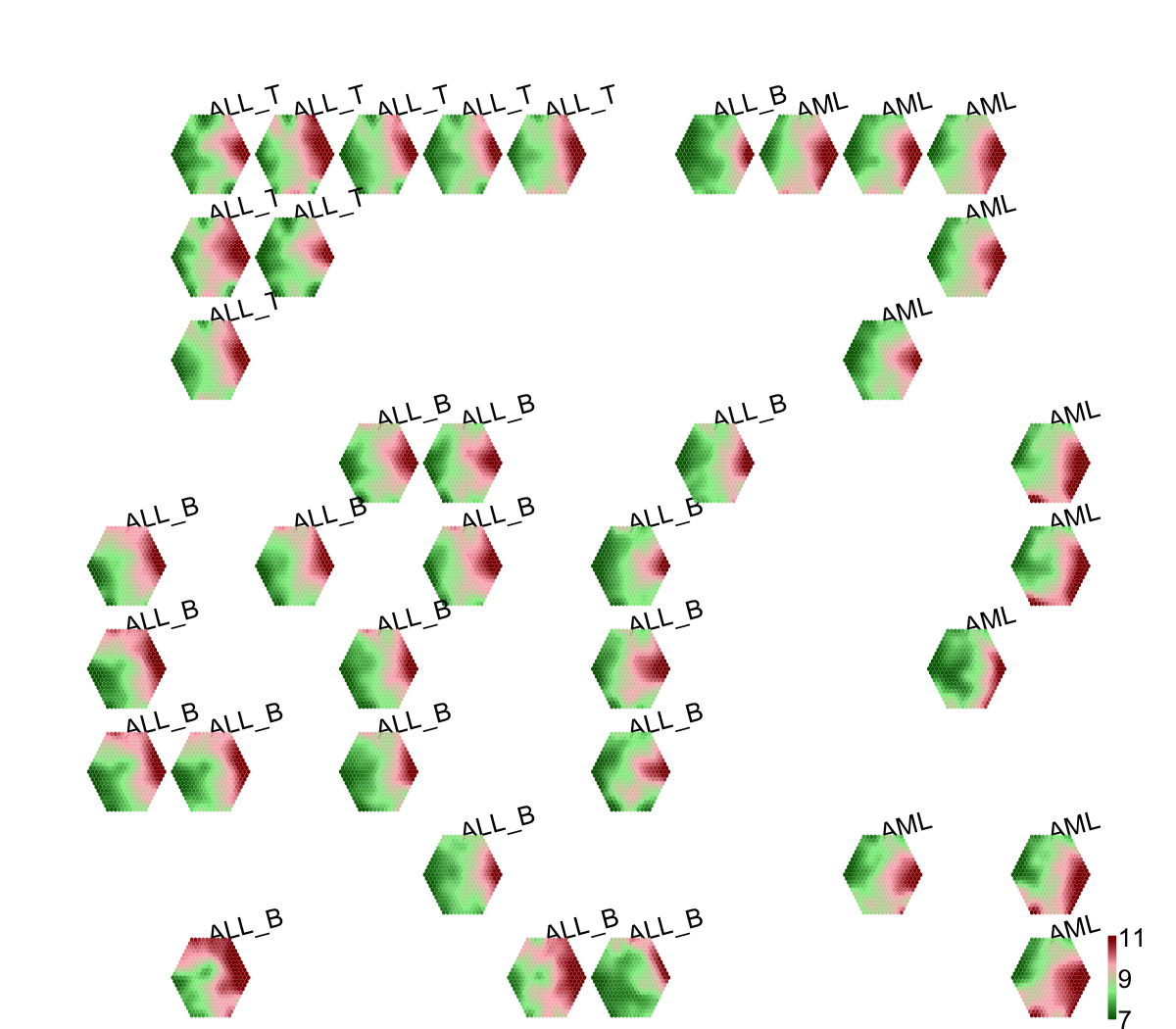 Start at 2016-06-24 11:45:51
First, build the tree (using nj algorithm and euclidean distance) from input matrix (38 by 3051)...
Second, perform bootstrap analysis with 100 replicates...
Finally, visualise the bootstrapped tree...
Finish at 2016-06-24 11:45:53
Runtime in total is: 2 secs
Start at 2016-06-24 11:45:51
First, build the tree (using nj algorithm and euclidean distance) from input matrix (38 by 3051)...
Second, perform bootstrap analysis with 100 replicates...
Finally, visualise the bootstrapped tree...
Finish at 2016-06-24 11:45:53
Runtime in total is: 2 secs
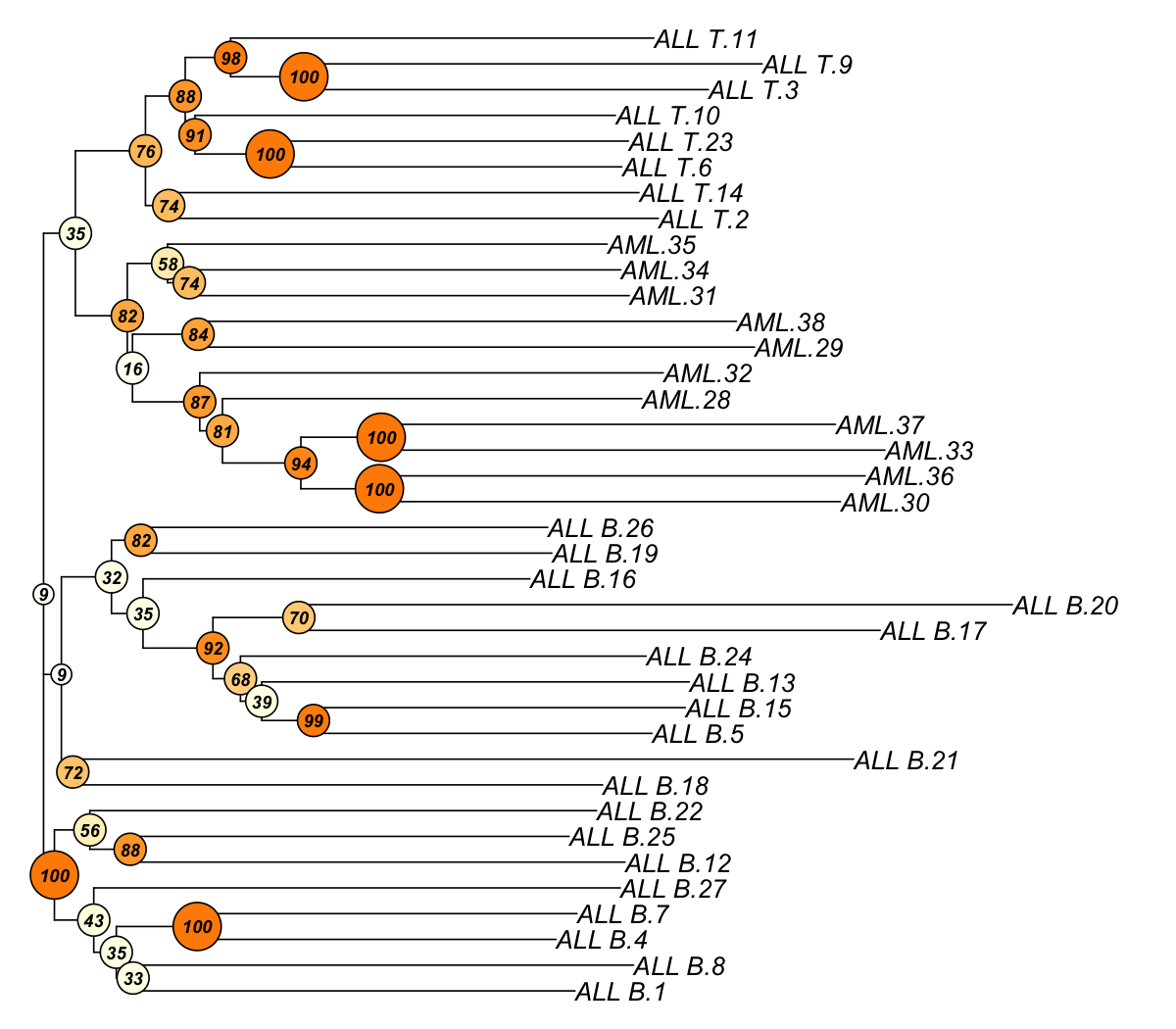
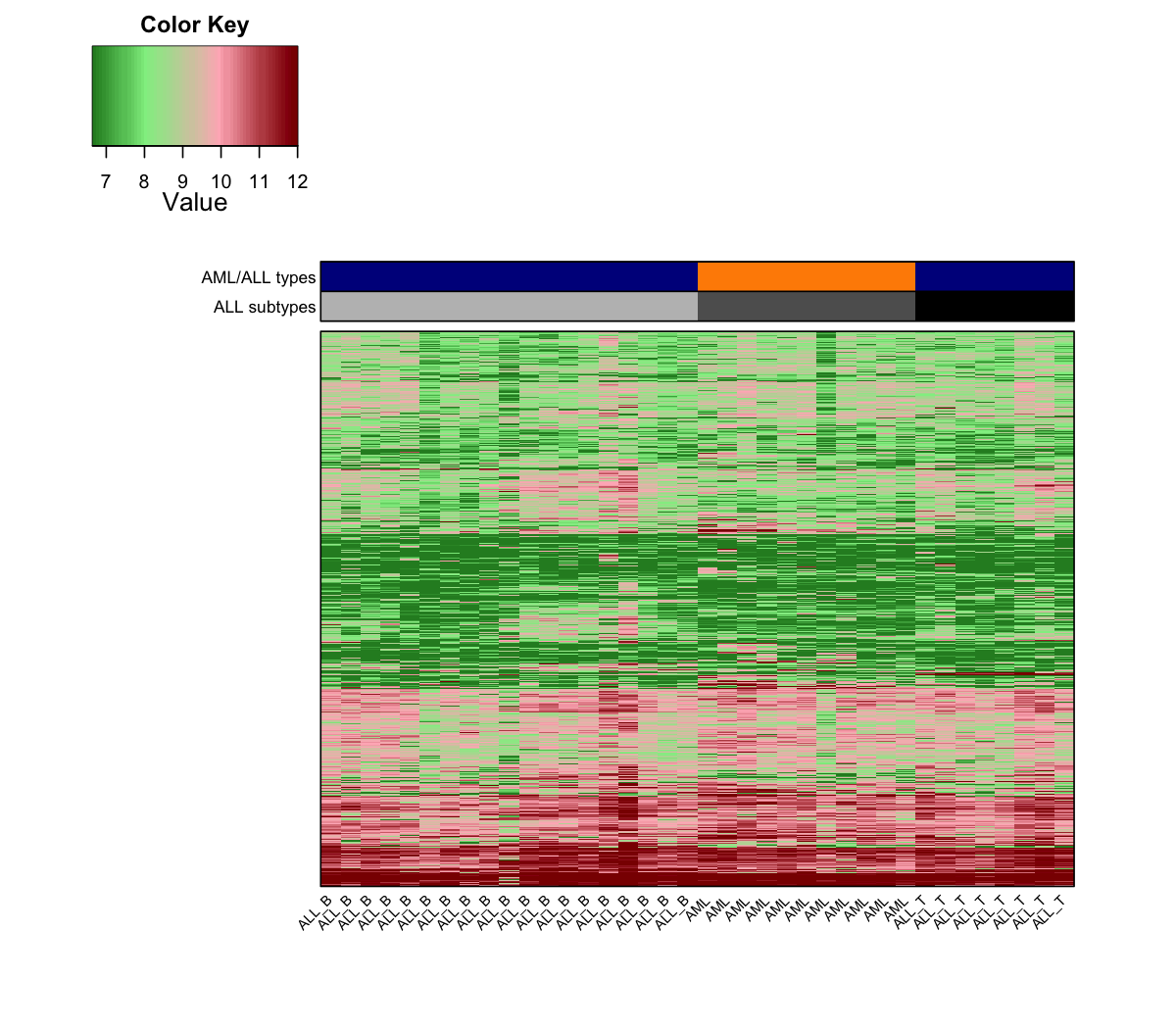
 ## As you have seen, a figure displays the multiple components of trained map in a sample-specific manner. You also see that a .txt file has been saved in your disk. The output file has 1st column for your input data ID (an integer; otherwise the row names of input data matrix), and 2nd column for the corresponding index of best-matching hexagons (i.e. gene clusters). You can also force the input data to be output; type ?sWriteData for details.
# (III) Visualise the map, including built-in indexes, data hits/distributions, distance between map nodes, and codebook matrix
visHexMapping(sMap, mappingType="indexes")
## As you have seen, the smaller hexagons in the supra-hexagonal map are indexed as follows: start from the center, and then expand circularly outwards, and for each circle increase in an anti-clock order.
visHexMapping(sMap, mappingType="hits")
## As you have seen, the number represents how many input data vectors are hitting each hexagon, the size of which is proportional to the number of hits.
visHexMapping(sMap, mappingType="dist")
## As you have seen, map distance tells how far each hexagon is away from its neighbors, and the size of each hexagon is proportional to this distance.
visHexPattern(sMap, plotType="lines")
## As you have seen, line plot displays the patterns associated with the codebook matrix. If multple colors are given, the points are also plotted. When the pattern involves both positive and negative values, zero horizental line is also shown.
visHexPattern(sMap, plotType="bars")
## As you have seen, bar plot displays the patterns associated with the codebook matrix. When the pattern involves both positive and negative values, the zero horizental line is in the middle of the hexagon; otherwise at the top of the hexagon for all negative values, and at the bottom for all positive values.
# (IV) Perform partitioning operation on the map to obtain continuous clusters (i.e. gene meta-clusters) as they are different from gene clusters in an individual map node
sBase <- sDmatCluster(sMap)
## As you have seen, a figure displays the multiple components of trained map in a sample-specific manner. You also see that a .txt file has been saved in your disk. The output file has 1st column for your input data ID (an integer; otherwise the row names of input data matrix), and 2nd column for the corresponding index of best-matching hexagons (i.e. gene clusters). You can also force the input data to be output; type ?sWriteData for details.
# (III) Visualise the map, including built-in indexes, data hits/distributions, distance between map nodes, and codebook matrix
visHexMapping(sMap, mappingType="indexes")
## As you have seen, the smaller hexagons in the supra-hexagonal map are indexed as follows: start from the center, and then expand circularly outwards, and for each circle increase in an anti-clock order.
visHexMapping(sMap, mappingType="hits")
## As you have seen, the number represents how many input data vectors are hitting each hexagon, the size of which is proportional to the number of hits.
visHexMapping(sMap, mappingType="dist")
## As you have seen, map distance tells how far each hexagon is away from its neighbors, and the size of each hexagon is proportional to this distance.
visHexPattern(sMap, plotType="lines")
## As you have seen, line plot displays the patterns associated with the codebook matrix. If multple colors are given, the points are also plotted. When the pattern involves both positive and negative values, zero horizental line is also shown.
visHexPattern(sMap, plotType="bars")
## As you have seen, bar plot displays the patterns associated with the codebook matrix. When the pattern involves both positive and negative values, the zero horizental line is in the middle of the hexagon; otherwise at the top of the hexagon for all negative values, and at the bottom for all positive values.
# (IV) Perform partitioning operation on the map to obtain continuous clusters (i.e. gene meta-clusters) as they are different from gene clusters in an individual map node
sBase <- sDmatCluster(sMap)
 visDmatCluster(sMap, sBase)
sWriteData(sMap, data, sBase, filename="Output_base_Golub.txt")
visDmatCluster(sMap, sBase)
sWriteData(sMap, data, sBase, filename="Output_base_Golub.txt")
 ## As you have seen, each cluster is filled with the same continuous color, and the cluster index is marked in the seed node. Although different clusters are coded using different colors (randomly generated), it is unavoidable to have very similar colors filling in neighbouring clusters. In other words, neighbouring clusters are visually indiscernible. In this confusing situation, you can rerun the command visDmatCluster(sMap, sBase) until neighbouring clusters are indeed filled with very different colors. An output .txt file has been saved in your disk. This file has 1st column for your input data ID (an integer; otherwise the row names of input data matrix), and 2nd column for the corresponding index of best-matching hexagons (i.e. gene clusters), and 3rd column for the cluster bases (i.e. gene meta-clusters). You can also force the input data to be output; type ?sWriteData for details.
# (V) Reorder the sample-specific components of the map to delineate relationships between samples
sReorder <- sCompReorder(data,metric="pearson") # see Figure 8
Start at 2016-06-24 11:45:47
First, define topology of a map grid (2016-06-24 11:45:47)...
Second, initialise the codebook matrix (117 X 38) using 'linear' initialisation, given a topology and input data (2016-06-24 11:45:47)...
Third, get training at the rough stage (2016-06-24 11:45:47)...
1 out of 1178 (2016-06-24 11:45:47)
118 out of 1178 (2016-06-24 11:45:47)
236 out of 1178 (2016-06-24 11:45:47)
354 out of 1178 (2016-06-24 11:45:47)
472 out of 1178 (2016-06-24 11:45:47)
590 out of 1178 (2016-06-24 11:45:47)
708 out of 1178 (2016-06-24 11:45:47)
826 out of 1178 (2016-06-24 11:45:47)
944 out of 1178 (2016-06-24 11:45:47)
1062 out of 1178 (2016-06-24 11:45:47)
1178 out of 1178 (2016-06-24 11:45:47)
Fourth, get training at the finetune stage (2016-06-24 11:45:47)...
1 out of 4712 (2016-06-24 11:45:47)
472 out of 4712 (2016-06-24 11:45:48)
944 out of 4712 (2016-06-24 11:45:48)
1416 out of 4712 (2016-06-24 11:45:48)
1888 out of 4712 (2016-06-24 11:45:49)
2360 out of 4712 (2016-06-24 11:45:49)
2832 out of 4712 (2016-06-24 11:45:49)
3304 out of 4712 (2016-06-24 11:45:50)
3776 out of 4712 (2016-06-24 11:45:50)
4248 out of 4712 (2016-06-24 11:45:50)
4712 out of 4712 (2016-06-24 11:45:51)
Next, identify the best-matching hexagon/rectangle for the input data (2016-06-24 11:45:51)...
Finally, append the response data (hits and mqe) into the sMap object (2016-06-24 11:45:51)...
Below are the summaries of the training results:
dimension of input data: 38x38
xy-dimension of map grid: xdim=13, ydim=9
grid lattice: rect
grid shape: sheet
dimension of grid coord: 117x2
initialisation method: linear
dimension of codebook matrix: 117x38
mean quantization error: 0.0621784272542971
Below are the details of trainology:
training algorithm: sequential
alpha type: invert
training neighborhood kernel: gaussian
trainlength (x input data length): 31 at rough stage; 124 at finetune stage
radius (at rough stage): from 2 to 1
radius (at finetune stage): from 1 to 1
End at 2016-06-24 11:45:51
Runtime in total is: 4 secs
visCompReorder(sMap,sReorder,title.rotate=15,colormap="darkgreen-lightgreen-lightpink-darkred")
## As you have seen, reordered components of trained map is displayed. Each component illustrates a sample-specific map and is placed within a two-dimensional rectangular lattice. Across components/samples, genes with similar expression patterns are mapped onto the same position of the map. Geometric locations of components delineate relationships between components/samples, that is, samples with the similar expression profiles are placed closer to each other.
# (VI) Build and visualise the bootstrapped tree
D <- t(data)
## As you have seen, each cluster is filled with the same continuous color, and the cluster index is marked in the seed node. Although different clusters are coded using different colors (randomly generated), it is unavoidable to have very similar colors filling in neighbouring clusters. In other words, neighbouring clusters are visually indiscernible. In this confusing situation, you can rerun the command visDmatCluster(sMap, sBase) until neighbouring clusters are indeed filled with very different colors. An output .txt file has been saved in your disk. This file has 1st column for your input data ID (an integer; otherwise the row names of input data matrix), and 2nd column for the corresponding index of best-matching hexagons (i.e. gene clusters), and 3rd column for the cluster bases (i.e. gene meta-clusters). You can also force the input data to be output; type ?sWriteData for details.
# (V) Reorder the sample-specific components of the map to delineate relationships between samples
sReorder <- sCompReorder(data,metric="pearson") # see Figure 8
Start at 2016-06-24 11:45:47
First, define topology of a map grid (2016-06-24 11:45:47)...
Second, initialise the codebook matrix (117 X 38) using 'linear' initialisation, given a topology and input data (2016-06-24 11:45:47)...
Third, get training at the rough stage (2016-06-24 11:45:47)...
1 out of 1178 (2016-06-24 11:45:47)
118 out of 1178 (2016-06-24 11:45:47)
236 out of 1178 (2016-06-24 11:45:47)
354 out of 1178 (2016-06-24 11:45:47)
472 out of 1178 (2016-06-24 11:45:47)
590 out of 1178 (2016-06-24 11:45:47)
708 out of 1178 (2016-06-24 11:45:47)
826 out of 1178 (2016-06-24 11:45:47)
944 out of 1178 (2016-06-24 11:45:47)
1062 out of 1178 (2016-06-24 11:45:47)
1178 out of 1178 (2016-06-24 11:45:47)
Fourth, get training at the finetune stage (2016-06-24 11:45:47)...
1 out of 4712 (2016-06-24 11:45:47)
472 out of 4712 (2016-06-24 11:45:48)
944 out of 4712 (2016-06-24 11:45:48)
1416 out of 4712 (2016-06-24 11:45:48)
1888 out of 4712 (2016-06-24 11:45:49)
2360 out of 4712 (2016-06-24 11:45:49)
2832 out of 4712 (2016-06-24 11:45:49)
3304 out of 4712 (2016-06-24 11:45:50)
3776 out of 4712 (2016-06-24 11:45:50)
4248 out of 4712 (2016-06-24 11:45:50)
4712 out of 4712 (2016-06-24 11:45:51)
Next, identify the best-matching hexagon/rectangle for the input data (2016-06-24 11:45:51)...
Finally, append the response data (hits and mqe) into the sMap object (2016-06-24 11:45:51)...
Below are the summaries of the training results:
dimension of input data: 38x38
xy-dimension of map grid: xdim=13, ydim=9
grid lattice: rect
grid shape: sheet
dimension of grid coord: 117x2
initialisation method: linear
dimension of codebook matrix: 117x38
mean quantization error: 0.0621784272542971
Below are the details of trainology:
training algorithm: sequential
alpha type: invert
training neighborhood kernel: gaussian
trainlength (x input data length): 31 at rough stage; 124 at finetune stage
radius (at rough stage): from 2 to 1
radius (at finetune stage): from 1 to 1
End at 2016-06-24 11:45:51
Runtime in total is: 4 secs
visCompReorder(sMap,sReorder,title.rotate=15,colormap="darkgreen-lightgreen-lightpink-darkred")
## As you have seen, reordered components of trained map is displayed. Each component illustrates a sample-specific map and is placed within a two-dimensional rectangular lattice. Across components/samples, genes with similar expression patterns are mapped onto the same position of the map. Geometric locations of components delineate relationships between components/samples, that is, samples with the similar expression profiles are placed closer to each other.
# (VI) Build and visualise the bootstrapped tree
D <- t(data)
 rownames(D) <- paste(rownames(D), 1:nrow(D), sep=".") # temporally make sure the row names are unique
tree_bs <- visTreeBootstrap(D, nodelabels.arg=list(cex=0.7))
Start at 2016-06-24 11:45:51
First, build the tree (using nj algorithm and euclidean distance) from input matrix (38 by 3051)...
Second, perform bootstrap analysis with 100 replicates...
Finally, visualise the bootstrapped tree...
Finish at 2016-06-24 11:45:53
Runtime in total is: 2 secs
rownames(D) <- paste(rownames(D), 1:nrow(D), sep=".") # temporally make sure the row names are unique
tree_bs <- visTreeBootstrap(D, nodelabels.arg=list(cex=0.7))
Start at 2016-06-24 11:45:51
First, build the tree (using nj algorithm and euclidean distance) from input matrix (38 by 3051)...
Second, perform bootstrap analysis with 100 replicates...
Finally, visualise the bootstrapped tree...
Finish at 2016-06-24 11:45:53
Runtime in total is: 2 secs
 ## As you have seen, neighbour-joining tree is constructed based on pairwise euclidean distance matrices between samples. The robustness of tree branching is evaluated using bootstraping. In internal nodes (also color-coded), the number represents the proportion of bootstrapped trees that support the observed internal branching. The higher the number, the more robust the tree branching. 100 means that the internal branching is always observed by resampling characters/genes.
# (VII) Visualise the matrix using heatmap
# The samples are ordered according to the neighbour-joining tree
flag <- match(tree_bs$tip.label, rownames(D))
rownames(D) <- sub("\\.\\d+$", "", rownames(D)) # restore the original names
D <- D[flag,]
# prepare colors for the column sidebar of heatmap
# color for AML/ALL types
types <- sub("_.*","",rownames(D))
lvs <- unique(types)
lvs_color <- visColormap(colormap="darkblue-darkorange")(length(lvs))
col_types <- sapply(types, function(x) lvs_color[x==lvs])
# color for ALL subtypes
subtypes <- sub(".*_","",rownames(D))
lvs <- unique(subtypes)
lvs_color <- visColormap(colormap="gray-black")(length(lvs))
col_subtypes <- sapply(subtypes, function(x) lvs_color[x==lvs])
# combine both color vectors
ColSideColors <- cbind(col_subtypes,col_types)
colnames(ColSideColors) <- c("ALL subtypes", "AML/ALL types")
# heatmap embeded with sidebars annotating samples
visHeatmapAdv(t(D), Rowv=T, Colv=F, dendrogram="none", colormap="darkgreen-lightgreen-lightpink-darkred", ColSideColors=ColSideColors, ColSideHeight=0.4, ColSideLabelLocation="left", labRow=NA)
## As you have seen, neighbour-joining tree is constructed based on pairwise euclidean distance matrices between samples. The robustness of tree branching is evaluated using bootstraping. In internal nodes (also color-coded), the number represents the proportion of bootstrapped trees that support the observed internal branching. The higher the number, the more robust the tree branching. 100 means that the internal branching is always observed by resampling characters/genes.
# (VII) Visualise the matrix using heatmap
# The samples are ordered according to the neighbour-joining tree
flag <- match(tree_bs$tip.label, rownames(D))
rownames(D) <- sub("\\.\\d+$", "", rownames(D)) # restore the original names
D <- D[flag,]
# prepare colors for the column sidebar of heatmap
# color for AML/ALL types
types <- sub("_.*","",rownames(D))
lvs <- unique(types)
lvs_color <- visColormap(colormap="darkblue-darkorange")(length(lvs))
col_types <- sapply(types, function(x) lvs_color[x==lvs])
# color for ALL subtypes
subtypes <- sub(".*_","",rownames(D))
lvs <- unique(subtypes)
lvs_color <- visColormap(colormap="gray-black")(length(lvs))
col_subtypes <- sapply(subtypes, function(x) lvs_color[x==lvs])
# combine both color vectors
ColSideColors <- cbind(col_subtypes,col_types)
colnames(ColSideColors) <- c("ALL subtypes", "AML/ALL types")
# heatmap embeded with sidebars annotating samples
visHeatmapAdv(t(D), Rowv=T, Colv=F, dendrogram="none", colormap="darkgreen-lightgreen-lightpink-darkred", ColSideColors=ColSideColors, ColSideHeight=0.4, ColSideLabelLocation="left", labRow=NA)
